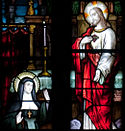Apparitions
Some young people who claimed to have seen the apparitions were Fernande (15), Gilberte (13), and Albert (11), children of Hector and Marie-Louise Perpète Voisin. Hector Voisin was a railway clerk. With them were Andrée (14) and Gilberte (9) Degeimbre, daughters of Degeimbre, a farmer's widow. [2]
On the evening of 29 November 1932, four of the children walked to a school conducted by the Sisters of Christian Doctrine to meet Gilberte Voisin and walk home with her. When they reached the school, Albert pointed out a lady dressed in a long white robe, walking in the air over a railroad viaduct just past the school. The other children reported seeing her as well. Over the next several weeks, they saw the lady thirty-two more times, generally in the garden of the convent-school. The final apparition was on 3 January 1933. [3]
The children reported that the lady requested that a chapel be built at the site and stated that "I am the Immaculate Virgin". She also desired for pilgrims to come to the site and asked the children (and everyone) to "pray, pray, pray" and, in one of the last visions, revealed her "Golden Heart". [4]
In the final vision, the Lady asked one of the children, Fernande, "Do you love My Son?" and she replied, "Yes". She then asked her "Do you love Me?" and Fernande again answered, "Yes". The Lady then stated, "Then sacrifice yourself for me" and bade them farewell before the child could reply.
Ecclesiastical review
In 1935, the Bishop of Namur, Thomas-Louis Heylen, appointed an Episcopal Commission to investigate the events. The work continued under his successor, Bishop André-Marie Charue. On 2 February 1943, he published a decree authorizing public devotions to Our Lady of Beauraing.
The final approbation for the Marian apparition was granted in 1949 with the permission of the Holy Office. [5] [6] [7]
In 1949 in Lowell, Massachusetts, the Pro Maria Committee was founded by Joseph Debergh, O.M.I. to disseminate the story of Our Lady's thirty-three appearances in Beauraing. The committee created an archive of photographs of the history and activities relating to the apparitions, now housed at The Marian Library/International Marian Research Institute. [8]
After the apparitions, the five children all grew up, married, and lived quiet lives with their families. [3] Pope John Paul II visited Beauraing on 18 May 1985.

A Marian apparition is a reported supernatural appearance by Mary the mother of Jesus, or a series of related such appearances during a period of time.

Beauraing is a city and municipality of Wallonia located in the province of Namur, Belgium. On January 1, 2018, Beauraing had a total population of 9,160. The total area is 174.55 km2, giving a population density of 52 inhabitants per km2.
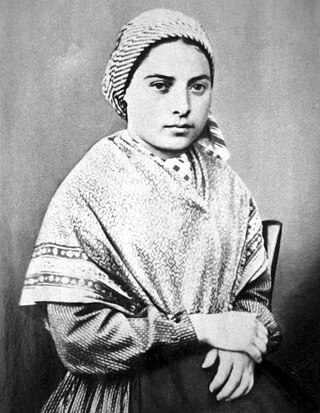
Bernadette Soubirous, also known as Bernadette of Lourdes, was the firstborn daughter of a miller from Lourdes, in the department of Hautes-Pyrénées in France, and is best known for experiencing apparitions of a "young lady" who asked for a chapel to be built at the nearby cave-grotto. These apparitions occurred between 11 February and 16 July 1858, and the woman who appeared to her identified herself as the "Immaculate Conception".

Our Lady of Fátima is a Catholic title of Mary, mother of Jesus, based on the Marian apparitions reported in 1917 by three shepherd children at the Cova da Iria in Fátima, Portugal. The three children were Lúcia dos Santos and her cousins Francisco and Jacinta Marto. José Alves Correia da Silva, Bishop of Leiria, declared the events worthy of belief on 13 October 1930.

Francisco de Jesus Marto and Jacinta de Jesus Marto were siblings from Aljustrel, a small hamlet near Fátima, Portugal, who, with their cousin Lúcia dos Santos (1907–2005), reportedly witnessed three apparitions of the Angel of Peace in 1916, and several apparitions of the Blessed Virgin Mary at Cova da Iria in 1917. The title Our Lady of Fátima was given to the Virgin Mary as a result, and the Sanctuary of Fátima became a major centre of world Christian pilgrimage.

The Sanctuary of Our Lady of Knock, commonly referred to as Knock Shrine, is a Roman Catholic pilgrimage site and national shrine in the village of Knock, County Mayo, Ireland, where locals claimed to have seen an apparition in 1879 of the Blessed Virgin Mary, Saint Joseph, Saint John the Evangelist, angels, and Jesus Christ.
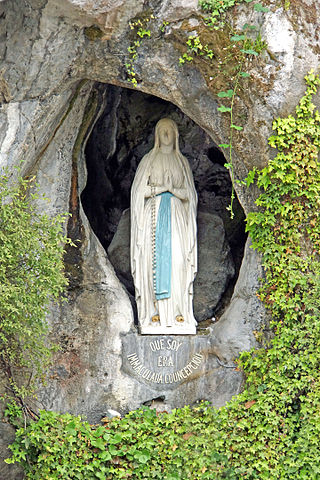
Our Lady of Lourdes is a title of the Virgin Mary. She is venerated under this title by the Roman Catholic Church due to her apparitions that occurred in Lourdes, France. The first apparition of 11 February 1858, of which Bernadette Soubirous told her mother that a "Lady" spoke to her in the cave of Massabielle while she was gathering firewood with her sister and a friend. Similar apparitions of the "Lady" were reported on 18 occasions that year, until the climax revelation in which she introduced herself as: "the Immaculate Conception". On 18 January 1862, the local Bishop of Tarbes Bertrand-Sévère Laurence endorsed the veneration of the Blessed Virgin Mary in Lourdes.
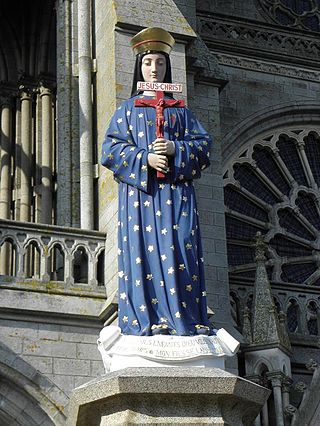
Our Lady of Pontmain, also known as Our Lady of Hope, is the title given to the Virgin Mary following her apparition at Pontmain, France on 17 January 1871.

The National Shrine of Our Lady of Champion, formerly dedicated as the Shrine of Our Lady of Good Help, is a Catholic shrine to Mary, mother of Jesus located within the Roman Catholic Diocese of Green Bay in the United States. The chapel is in the Champion section of Green Bay, about 16 miles (26 km) northeast of downtown Green Bay proper. It stands on the site of the reported apparition of Mary to a Belgian-born woman, Adele Brise, in 1859.
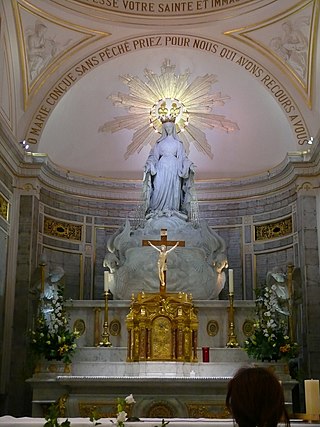
The Chapel of Graces of the Miraculous Virgin or informally the Chapel of Our Lady of the Miraculous Medal, is a Marian shrine located in Paris, France.
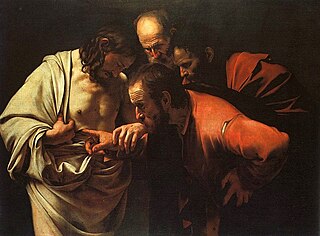
A number of people have claimed to have had visions of Jesus Christ and personal conversations with him. Some people make similar claims regarding his mother, Mary. Discussions about the authenticity of these visions have often invited controversy. The Catholic Church endorses a fraction of these claims, and various visionaries it accepts have achieved beatification, or even sainthood.

The Lourdes apparitions are several Marian apparitions reported in 1858 by Bernadette Soubirous, the 14-year-old daughter of a miller, in the town of Lourdes in Southern France.

The veneration of Mary in the Catholic Church encompasses various devotions which include prayer, pious acts, visual arts, poetry, and music devoted to her. Popes have encouraged it, while also taking steps to reform some manifestations of it. The Holy See has insisted on the importance of distinguishing "true from false devotion, and authentic doctrine from its deformations by excess or defect". There are significantly more titles, feasts, and venerative Marian practices among Roman Catholics than in other Western Christian traditions. The term hyperdulia indicates the special veneration due to Mary, greater than the ordinary dulia for other saints, but utterly unlike the latria due only to God.
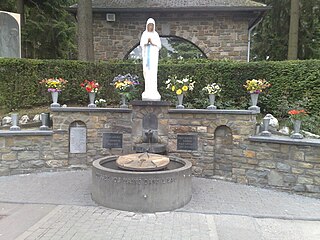
Our Lady of Banneux, or Our Lady of the Poor, is the sobriquet given to the apparition of the Virgin Mary to Mariette Beco, an adolescent girl living in Banneux, Liège Province, Belgium. Between 15 January and 2 March 1933 Beco told her family and parish priest of seeing a Lady in white who declared herself to be the "Virgin of the Poor", saying I come to relieve suffering and Believe in me and I will believe in you.

"Immaculate Mary" or "Immaculate Mother" is a popular Roman Catholic Marian hymn. It is also known as the Lourdes Hymn, a term which also refers to the hymn tune itself. It is often sung in honour of the Immaculate Conception of the Blessed Virgin Mary.

The Basilica of Our Lady of Tongre is a Roman Catholic parish church and minor basilica in Tongre-Notre-Dame, Chièvres, Belgium. The shrine is small, yet rich in historical significance.
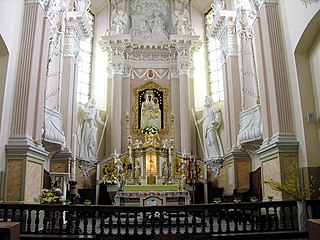
Our Lady of Šiluva is Roman Catholic image of the Blessed Virgin Mary venerated at the Basilica of the Nativity of the Blessed Virgin Mary, Šiluva shrine in Lithuania. The patriotic icon is highly venerated in Lithuania and is often called Lithuania's greatest treasure.

Our Lady of Pellevoisin is a title of the Blessed Virgin Mary which refers to a series of Marian apparitions in Pellevoisin, Indre, France. Pellevoisin is west of Châteauroux in the Catholic Archdiocese of Bourges.

Our Lady of the Rosary of San Nicolás is, in Catholicism, a title of veneration of the Blessed Virgin Mary associated with a reported private revelation to Gladys Quiroga de Motta, a middle-aged housewife, beginning in the 1980s in the city of San Nicolás de los Arroyos, Argentina. Quiroga said that she was tasked with promoting devotion to the Mother of God under this title, with an emphasis on key passages in the Bible and a particular mystical stellar symbolism.



